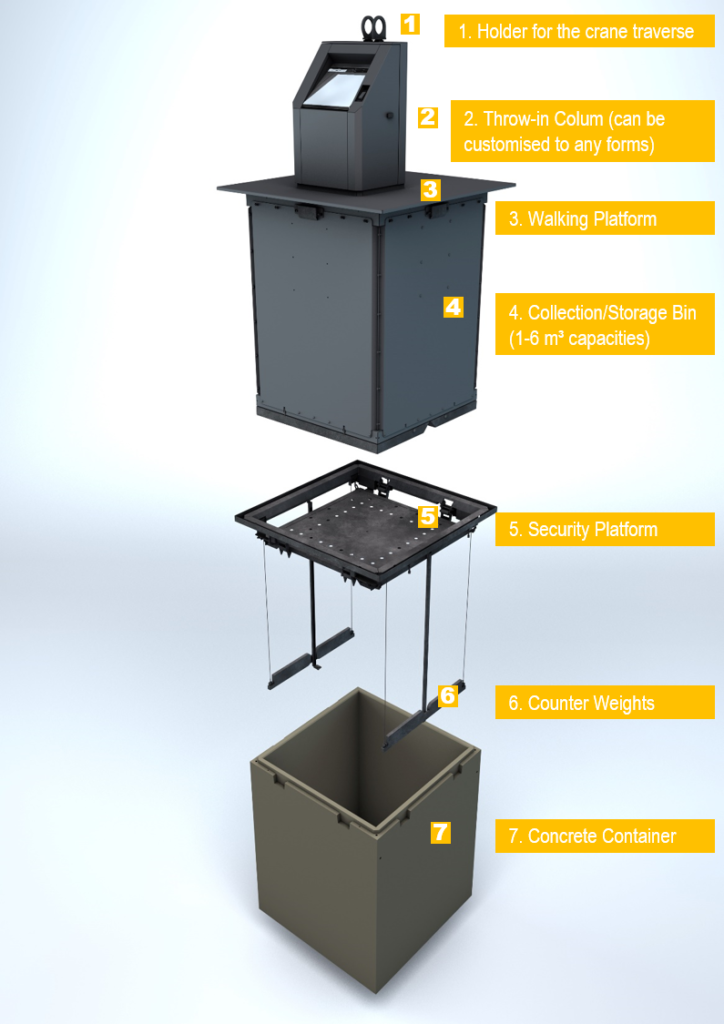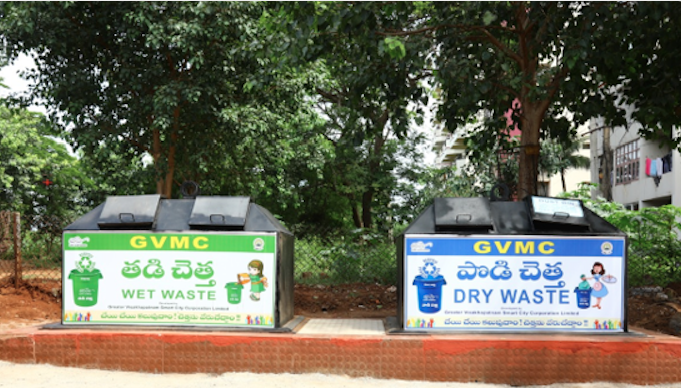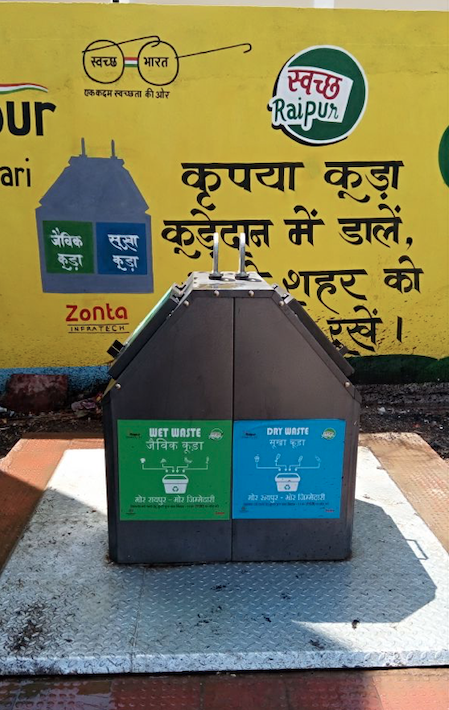
In 2014, Zonta installed its first set of 300 semi-underground bins in India. Ever since, their clientele for this exclusive product, manufactured in Bengaluru, has expanded to over 20 cities and sales continue to grow. Recently, the Visakhapatnam Municipal Commissioner acknowledged that the semi-underground bin project implemented in the city has been shortlisted under Swachh Bharat Mission (Urban) category for the Prime Minister’s Excellence Award 2020.
SolidWasteIndia.com recently spoke with Dusseldorf-based Managing Director of Zonta Global Infratech GmbH, Mr Dennis Eapen Pulimittathu to find out more on the technology behind this transformative waste collection solution and their plans for the future.
Q1) What is so unique about Zonta’s underground waste collection bins?
Zonta is the largest manufacturer of underground and semi-ground bins in India. Unlike other firms that supply ordinary plastic bins or expensive imported bins, we cater to unique local requirements of the domestic market using our own technology from Germany. Zonta’s bin containers are made of durable hot dipped galvanised steel which are placed inside concrete structures under the subsurface of the ground. Above ground, depending on their unique design, customized throw-in columns are mounted on ground level plateaus, which can also be easily accessed by everyone, including wheelchair users, children as well as municipal workers using various equipments.
Our underground bins are also equipped with fill-level sensors, called ZenZit, a self-learning algorithm that independently creates the most efficient collection routes from the fill level data from bins. The routes are then transferred directly to the truck driver’s navigation device to ensure timely pick-up.
Further, our underground bins are emptied using a mechanized system by specialized vehicles. Thus, in COVID-19 times, our systems provide a safe operating environment for the workers, ensuring no direct contact with the waste during operations.
Q2) What is the advantage of installing underground bins as compared to overground ones?
To begin with,we can provide higher collection as well as storage capacity through the usage of underground bins by utilizing the sub-surface in the same area or even lesser than the area used by the overground bins. They are helpful in avoiding garbage ‘blackspots’ that are such a common sight and also help in eliminating littering around the bin area.
Most of our bins are pedal-assisted, which users find hygienic and convenient to use. Also, as mentioned above, these bins accord a sense of dignity to employees who don’t have to touch the waste since the collection process is mechanized.

The smart ZenZit technology in our bins gives considerable flexibility, security and transparency in waste collection systems. An analysis of the long-term data also allows authorities to make recommendations for new container locations. The logistics of waste collection, including transportation and labor cost, is also reduced by about 15 percent. This also means a significant reduction in CO2 and nitrogen oxide emissions for the cities concerned.
I also want to highlight that it in cities where these underground bins have been installed, it has been observed that the perception of the users regarding waste has changed. Segregation-related awareness and collection efficiency has also started to increase where assets for segregated collection are provided. Smart Cities are very keen to install underground bins.
In the long term, I am optimistic that with the implementation of EPR rules, these bins will prove further advantageous and facilitate recycling.
Q3) Underground bins are common in Western countries but in the Indian context, where user behaviour is still fairly erratic, how effective are these bins?

In countries like Germany, underground bins are a tool to achieve better recycling. However, in India, we have adapted these bins to meet local realities. Our ULBs are overloaded with waste collection responsibilities and have to manage multiple overground wheely bins. Not only is this inefficient, but also an eyesore.
Thus, our large volume bins of up to 6 cubic meters are used by ULBs for residual waste collection, which reduces their burden and the cityscape looks good too. Patiala is a great example. They have installed our semi-underground bins throughout the city, along with press containers in high-volume waste areas, which can collect up to 12 cubic metres of garbage, making the city look very clean. In 2017, Patiala was among the dirtiest cities in India at 411th rank. In this year’s Swacch Survekshan it ranked 86.
Q4) What are some of the challenges you face in operating your bins in India?
User-behavior is still one of our biggest challenges. Many people don’t want to operate the bins with their hands and throw garbage outside the bin. This not only affects the landscape of the area but also attracts animals, which is a menace. We already have a solution for this – pedal assist bins. Bhopal installed these in the very beginning and all our newer clients are now opting for it. Yet, capacity building is required wherein citizens need to be made conscious of how and where they throw their waste.
In India, constant maintenance and painting is required. You might notice underground bins in India look different on the exterior from those seen in other countries. That’s only because we use paint materials that last longer.
Finally, we have no control over how the ULB disposes the waste collected in these bins. Owing to the overflowing landfills in India, waste is stored longer than desired since there is no facility that can accommodate it. However, unlike overground wheely bins overflowing with uncollected waste and animals, our underground bins are able to conceal the waste and keep the city looking clean on the outside, 24/7.

Q5) How do you justify the steep cost associated with underground bins to cash-strapped municipalities?
The life-cycle cost of these bins works out cheaper than regular bins. It makes more financial sense to invest in Zonta’s large underground bins than smaller, less-durable overground, wheeled ones which have to be purchased in multiple quantities and replaced constantly to achieve similar results. We haven’t had to replace a single bin in the last six years. They continue functioning as beautifully as they did when installed. Besides, our trained operators use lorry-mounted cranes to pick up the waste and maintain these bins which is an exceptional value. Damages caused due to vandalism and carelessness are rectified at regular intervals.
Also, there are tremendous savings in terms of land value. The use of underground space is vital in achieving environmentally friendly and sustainable development. It allows for activities or infrastructure whose installation above ground is difficult, ecologically undesirable – or even less profitable – to be moved underground, thus freeing valuable surface space for other uses and improving living conditions in cities.
Finally, these sophisticated underground bins can be viewed as a means to achieve better recycling. As waste segregation continues to rise in India, these bins can be equipped further and utilised as collection points for recycling rather than being used merely for residual waste collection. The informal sector can accordingly be reallocated to formal Material Recovery Facilities, which has additional socio-economic implications. Active redesign of the waste management systems and clever adaptation of new solutions are imperative as our country’s waste management system gets more streamlined.
In the long term, I am optimistic that with the implementation of EPR rules, these smart bins will prove advantageous and facilitate recycling.

Q6) What is the average cost of these bins?
It is not possible to share the cost of each bin since it is customized to the clients’ specific needs. We have innovative business models, so that cities do not have to spend unreasonable amounts on these bins. For instance, we provide a leasing option so the city can pay us over a longer period of time for these bins instead of upfront payment.
Q7) You are keen to emphasize the long-term benefits in investing in these underground bins…
Absolutely. The combination of today’s demand on modern town planners and varying conditions on location make it necessary to consider customized solutions utilizing the sub surface in emerging cities. The separate collection of residual waste and organic waste etc. is increasing among the population and also in most of the Indian cities today. If the systems are not adapted to the collection behaviour, volumes and local conditions, side-effects, such as overfilling, visual obstruction, noise and odour nuisance etcetera will arise.
I believe proper waste-collection is the spine of any waste management system. Moreover, active climate protection starts with waste separation or segregation of solid waste at homes/source. Our technologically advanced methods and services “ZOlutions” are proven worldwide to improve waste management practices that will reduce emissions from the sector and lead to cleaner, more sustainable cities. Zonta is a full-service waste management company which creates such an eco-friendly infrastructure, by designing, manufacturing and operating waste management to deliver long term sustainable benefits.
Picture Credit: Zonta Infratech



